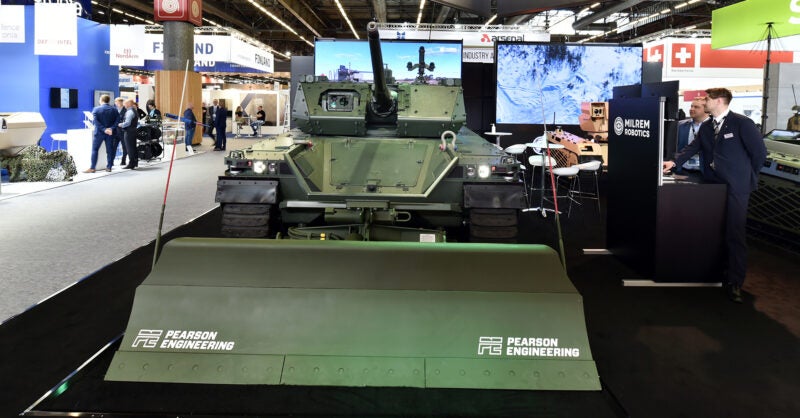 Following the successful integration of Pearson Engineering’s Light Weight Mine Roller to Milrem Robotics’ Type-X at DSEI 2021, the companies have continued their collaboration with a new integration for Eurosatory.
Following the successful integration of Pearson Engineering’s Light Weight Mine Roller to Milrem Robotics’ Type-X at DSEI 2021, the companies have continued their collaboration with a new integration for Eurosatory.
The two companies have successfully integrated Pearson Engineering’s straight obstacle blade, demonstrating the ability for Type-X to accept multiple types of Front-End Equipment to meet the demanding requirements of the modern battlefield. The blade being exhibited is designed to clear a 5 tonne obstacle and includes advanced pressure release features which ensure any abnormally high loads do not damage the host vehicle. The obstacle blade has been fitted using the same vehicle integration kit used at DSEI and exemplifies the rapid interchangeability inherent within Pearson Engineering’s design approach.
Business Development Director Mr Richard Beatson explained: “Robotic Combat Vehicles (RCVs) are the subject of much discussion and development, but it is yet to be fully determined how they will be used in an operational environment. Our collaboration highlights the possibilities for RCVs to undertake mobility, counter-mobility and survivability tasks, ensuring their own independent manoeuvre, and potentially supporting other vehicles to achieve their missions in the way that a typical armoured combat engineer vehicle would do”.
The Type-X Robotic Combat Vehicle (RCV) provides equal or overmatching firepower and tactical usage to a unit with Infantry Fighting vehicles. “Equipping it with Front-End Equipment gives mechanized units another critical capability and removes the need to jeopardise the lives in manned vehicles to perform high risk tasks”. explained Cpt (res) Jüri Pajuste, Director of Defence Research at Milrem Robotics.
The Type-X can be fitted with a cannon up to 50 mm. With a weight of 12 tons and efficient power management the vehicle has superior terrain capabilities. Its height of 2.2 m and a rear engine provide low visual and heat signature. The vehicle is equipped with intelligent functions such as follow-me, waypoint navigation and obstacle detection with Artificial Intelligence being part of the algorithms.
In recent years, Pearson Engineering has turned its attention to the development of products to support manoeuvre for a wider range of vehicles, equipping Main Battle Tanks to move around the battlefield unimpeded and enhancing other vehicles’ abilities to defeat ordnance and other obstacles.
Milrem Robotics is the leader of a consortium awarded 30.6 MEUR from the European Commission’s European Defence Industrial Development Programme (EDIDP) to develop a European standardized unmanned ground system (UGS). During the project, titled iMUGS, modular and scalable architecture for hybrid manned-unmanned systems will be developed to standardize a European wide ecosystem.

